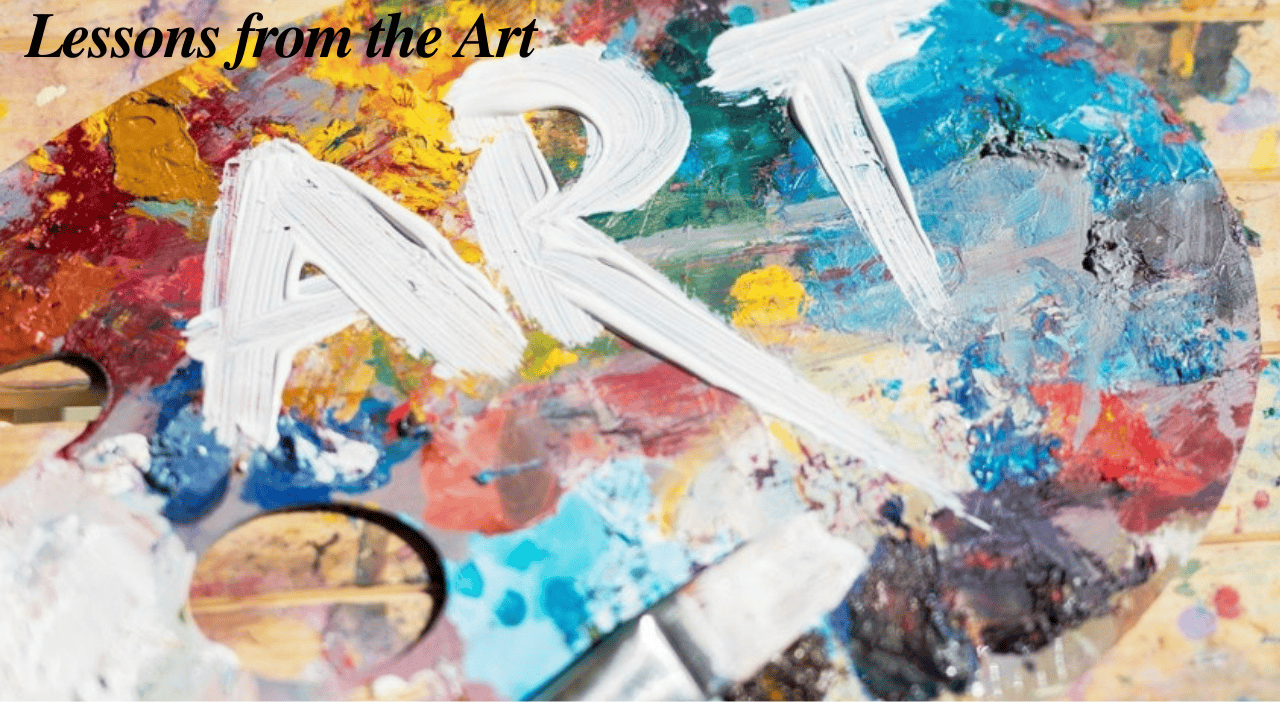In art, there lies an incredible power to shape our understanding of life, its challenges, and its beauty. Whether it’s through painting, sculpting, music, or dance, art distills a myriad of emotions, experiences, and perspectives that teach us invaluable life lessons. As we explore these lessons from art, we see that each creation offers insights into creativity, patience, and resilience—virtues crucial for navigating life.
What Is Lesson Art

Art’s role as a mirror to life goes beyond mere representation; it reflects the deepest aspects of human emotion, culture, and the shared human experience. From ancient cave paintings to modern installations, art has always provided a canvas to explore themes like joy, sorrow, conflict, and peace. This dual reflection between art and life brings to the forefront a dynamic understanding of how both are interwoven, offering profound perspectives on resilience, love, and self-expression.
Why Art is a Teacher of Life Lessons
The creative process requires an artist to engage with ideas, emotions, and methods in ways that demand introspection, openness, and patience. This same discipline is essential to personal growth and self-awareness, making art a natural teacher. Each stroke of a brush, note in a composition, or word in a poem offers insights into persistence, adaptability, and embracing imperfections—all lessons applicable to daily life.
Understanding Expression in Art and Its Relevance
Art encourages one to express what words often cannot. This lesson in expression is significant because life also demands an outlet for the unspeakable. When we observe or create art, we engage with layers of expression that teach us the value of self-awareness, introspection, and emotional release.
Perspective: Learning to See Beyond the Surface
A single piece of art can mean different things to different viewers, making perspective one of art’s great life lessons. Art challenges us to move beyond initial judgments and to consider various interpretations and viewpoints. In life, this same principle of shifting perspectives helps us build empathy, understanding, and open-mindedness—essential for navigating relationships and conflicts.
Patience and the Artistic Process
Creating art is seldom a fast process. An artist must go through planning, execution, and often, a multitude of revisions. This patience cultivated through art is invaluable in life, where immediate results are not always achievable,lessons from the art and persistence is key to success. Art teaches us to embrace the journey as much as the result, understanding that growth and improvement come through consistent effort and patience.
Creativity: Embracing the Unexpected
Art thrives on spontaneity and innovation. Often, the best ideas come from accidents or experiments gone awry, reminding us that unexpected outcomes aren’t necessarily failures but opportunities. This lesson in creativity underscores the importance of staying open to new experiences and adaptable to change, vital skills for personal and professional growth.
The Power of Perseverance in Art and Life
Art isn’t always easy; it can be filled with obstacles, from creative blocks to technical challenges. The resilience required to finish an artwork teaches us about the value of perseverance. In life, as in art,lessons from the art the ability to push forward despite setbacks builds strength, self-confidence, and ultimately, mastery over one’s craft or goals.
Embracing Mistakes as Part of the Journey
In many forms of art, mistakes are not erased but incorporated into the final piece, turning errors into unique features. Life, too, is filled with moments we wish we could redo, but art teaches us that our “mistakes” can become defining aspects of our journey. This approach fosters acceptance, resilience,lessons from the art and a sense of peace with imperfection.
Finding Beauty in Imperfection
The Japanese art form of kintsugi, where broken pottery is mended with gold, celebrates flaws rather than hiding them. This is a potent metaphor for life—embracing imperfections, whether in ourselves or others, can reveal unexpected beauty.lessons from the art Learning to appreciate the unique attributes in art translates to self-acceptance, showing us that flaws add richness and depth to our lives.
Adaptability: Adjusting to New Mediums and Styles
Artists often experiment with various mediums, from oils to watercolors or digital forms, each requiring a different approach. This adaptability highlights a crucial life lesson about flexibility and the willingness to try new things.lessons from the art Embracing change and exploring different paths allows growth and can lead to previously unimaginable outcomes.
Detail-Oriented Thinking: Seeing the Small Things
Art requires attention to detail, whether in the precision of a brushstroke or the intricacies of a musical composition. Focusing on small details teaches us to appreciate the little things in life, helping us to notice beauty, joy, and value in what might otherwise be overlooked.
Expression Through Colors: How Colors Influence Emotions
Colors are known to impact mood and energy levels; warm colors often evoke passion or warmth, while cool tones suggest calm or melancholy.lessons from the art Understanding the role of colors in art opens our awareness of how external elements can influence emotions, teaching us to be mindful of our environment and its effect on well-being.
Art as a Form of Mindfulness and Presence
Creating or viewing art encourages mindfulness, a state of focused awareness and presence. When immersed in the creative process, distractions fade away, allowing artists and viewers alike to experience the present moment fully.lessons from the art Practicing mindfulness through art can significantly reduce stress and cultivate a sense of peace, promoting mental clarity and emotional well-being.
Connection Through Art: Universal Communication
Art speaks a universal language that transcends borders, backgrounds, and languages. This ability to connect people, regardless of differences, teaches us the value of empathy and understanding. The universality of art fosters communication across diverse communities, helping bridge gaps and fostering compassion on a global scale.
Understanding Cultural Reflections in Art
Each piece of art tells the story of its time and place, capturing the values, beliefs, and struggles of a culture.lessons from the art Recognizing these cultural reflections in art builds awareness of our world’s diverse heritage and promotes respect and tolerance for others’ experiences and histories.
Symbolism and Hidden Meanings: Finding Deeper Layers
Artists often use symbolism to convey layered meanings within their work. These hidden messages teach us to look beneath the surface, both in art and in life, and to seek deeper understanding before forming conclusions.lessons from the art This depth of perception fosters critical thinking, curiosity, and an appreciation for complexity.
Discipline: The Role of Practice in Perfecting Art
Mastering any art form requires time, practice, and discipline. This dedication applies equally to life, where effort and consistency drive progress.lessons from the art Discipline in art reinforces the value of working towards goals with perseverance, encouraging a growth mindset and resilience.
Trusting the Process and Letting Go of Control
Sometimes, art evolves in unexpected ways, requiring the artist to let go of strict control. In life, too, the need for control can be limiting.lessons from the art Trusting the process, even when the outcome is uncertain, teaches us to accept ambiguity and embrace the journey with open-heartedness.
Exploring Identity Through Self-Expression in Art
Art allows individuals to explore and express their identities, revealing insights into who they are and what they stand for.lessons from the art By examining our creations or the art we gravitate towards, we gain self-awareness and clarity, empowering us to live more authentically.
The Art of Storytelling: Conveying Narratives Through Visuals
Art is a powerful medium for storytelling, allowing artists to communicate narratives, emotions, and insights without words.lessons from the art This form of storytelling is a lesson in empathy, enabling viewers to step into others’ experiences, understand diverse perspectives, and cultivate compassion.
Conclusion: Why Art Teaches Us About Life
Art, in all its forms, is more than an expression; it is a reflection of humanity and a profound teacher. From the patience it requires to the self-expression it encourages, art provides countless lessons that enhance our understanding of the world, of each other, and of ourselveslessons from the art . Embracing these lessons from the art world enriches our lives, making us not only better artists but more aware, compassionate, and resilient individuals.
FAQs
What life lessons can be learned from art?
How does art help with emotional expression?
Why is art important in understanding different perspectives?
What does patience in art teach about life?
How can creativity in art impact problem-solving in life?
What is the connection between art and mindfulness?











